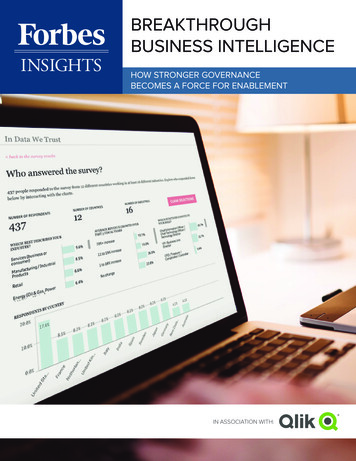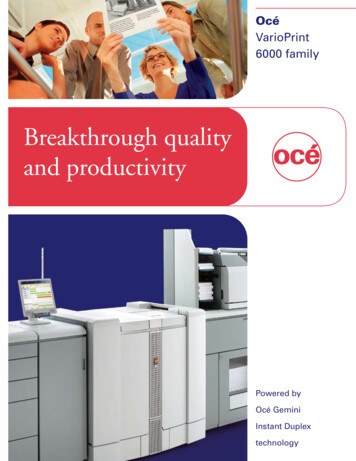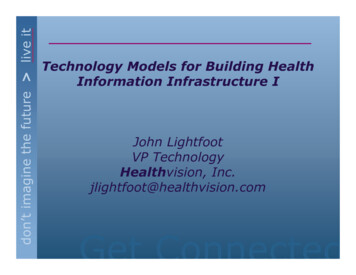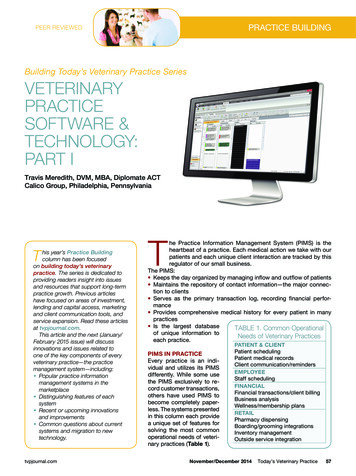
Transcription
Building BreakthroughBusiness ModelsJohn W. MullinsLondon Business School John Mullins 20091
Your Tasks 10 minutes: Read the case 5 minutes: Discuss in two and threes–Left half: Which revenue model? Simple calling plan or pay-as-you-go?–Right half: Which operating model? Subsidized handsets or no subsidy? John Mullins 20092
MSI Cellular Investments:What happened? John Mullins 20093
From a Business ModelPoint of View Five key elements in every business model–Revenue model–Gross margin model–Operating model–Working capital model–Investment model John Mullins 20094
MSI’s Revenue Model Rhodes’ view: Western calling plans are anantilog–Too much commitment to ask of people whohad never had phones–Too much to expect them to know how muchthey’d use a mobile phone Eastern Europe: an analog–Prepaid scratch cards are the answer: pay asyou go (with “beer money”) John Mullins 20095
MSI’s Gross Margin Model Gross margins would be high: movingelectrons is cheap! But took great care to make everythinguser-friendly–Minimize the need for call centre help–Literacy was marginal in many SSA countries John Mullins 20096
MSI’s Operating Model Eastern Europe: analog–GSM technology, no fancy billing system Western Europe: antilog–Free handsets burn cash His decision: no free handsets. Why?–Lower capital requirements to get started–Greater ability to grow the business over time John Mullins 20097
MSI’s Working Capital Model The revenue side–Customer buys a scratch card, day one–Puts cash in the till before services are rendered.Negative A/R. The expense side–Main expenses are for infrastructure: towers, switches,etc.–Vendors gave lengthy terms The result: negative working capital (businessmodel nirvana!) John Mullins 20098
MSI’s Investment Model Building mobile phone systems is not cheap–Governments to wine and dine–Licenses to win–Operating infrastructure to build Would investors play?–“I’m not going to Uganda without my hard hat.That’s where Idi Amin lives.” John Mullins 20099
Three Unanswered QuestionsRemained: MSI’s Leaps of Faith The investor question–Would investors invest in SSA? The license question–How expensive would African licenses be? The beer money question–Would impoverished SSA consumers actuallypay to buy and use mobile phones? John Mullins 200910
Would Investors Come on Board First, a rock-solid management team“We took the view that it was worth backing becauseyou had an entrepreneur who understood thetechnology requirements. And it was acommendably honest operation and did not involveany underhand payments.”Lord Cairn, CDC, an early investor John Mullins 200911
Second, and Equally Important:The Business Model Once up and running, the favorable workingcapital model should help fund futuregrowth–New customers mean more towers and switches,serving more communities–But each new customer generates cash flowfrom day one John Mullins 200912
Did Everyone Agree?“We were seen as slightly mad.Everyone knows you’ll nevermake money in Africa – they’reall crooks and incompetents.”Lord Cairn, CDC John Mullins 200913
What Aboutthe License Question? An answer from South Africa“Governments realized that becausereturns here are lower, the businessmodel just doesn’t stack up if theycharge big license fees.”A new South African operator John Mullins 200914
Testing the RemainingLeap of Faith Would customers in SSA spend beermoney – and more – on mobile phones?–The Eastern European analog suggested theywould–But Eastern Europe is not Africa, wherepoverty is daunting–Only one way to know for sure: launch thefirst system John Mullins 200915
MSI’s Rationale:More Talk, Less Walk“In Africa, there is hardly any alternative tomobile telephony, apart from traveling, whichcan be dangerous. So even for those withlower incomes, mobile telephony can be avery effective solution.”Marten Pieters, MSI Cellular John Mullins 200916
Guiding and Tracking theJourney: Build a Dashboard Much like the one in your car Two key metrics, once investors were onboard and licenses acquired–Acquisition cost per subscriber–ARPU: Average Revenue per User If these numbers pan out, there’s a businessin SSA If not, MSI dead in the water John Mullins 200917
MSI Starts Rolling 1998–Raised 16 million in equity, plus 15 million debt(the investor leap of faith answered)–Won licenses in Malawi, Zambia, Sierra Leone, andCongo-Brazzaville (the license leap of faithanswered) 1999–Raised another 35 million, plus 22.5 million debt–Won licenses in Gabon, Chad, DRC, and Guinea John Mullins 200918
2000: The Dashboard Speaks Acquisition cost per subscriber:–A small fraction of Europe’s figure–Mass advertising is cheap in SSA–Personal selling, too ARPU–Quickly reached 300 per year ( 25/month),similar to Europe – but widely varied The “beer money” leap of faith? No longer aquestion! John Mullins 200919
MSI Cellular: A Growth Machine 2001 and 2002–Built out the systems, licensed new SSAcountries at breakneck speed 2003–Turned profitable 2004–Renamed the business Celtel 2005–Sold Celtel for 3.4 billion (8 short years!) John Mullins 200920
Celtel: A Rare Case Where“Plan A” Has Worked But let’s face an uncomfortable fact. Mostnew ventures fail. Why? Most new businesses fail because thebusiness model doesn’t work!–Too little cash coming in –Too much cash going out. John Mullins 200921
My Assertion: Today’s Start-upProcess Is Seriously Flawed Driven by business plans based on naïveand unfounded assumptions All in support of a “Plan A” that rarelyworks And it’s not the entrepreneur’s fault John Mullins 200922
In the Words ofOne Angel Investor“I’ve made more money on PlanB than I ever made by stickingto Plan A!” John Mullins 200923
So, is there a solution to theflawed start-up process? A rigorous solution, perhaps, for getting fromyour Plan A that probably won’t work To a better Plan B, a better business model,based on–Real data–For a real product or service–From real customers John Mullins 200924
The Conventional BusinessPlanning Approach Turn on Excel Make silly “assumptions” (SWAGs)lacking in real evidence Tweak the cells to create a “hockey stick”pro forma Voila, you’ll soon be rich! John Mullins 200925
So, how can you develop a businessmodel that really stacks up? Turn off Excel and consider the fivebuilding blocks of every business model–What’s your revenue model?–Your gross margin model?–Your operating model?–Your working capital model?–And your investment model. John Mullins 200926
A Process to Get You There The story of Apple’s transformation John Mullins 200927
The Key Steps in Apple’s Journey Analogs Antilogs Leaps of faith Hypotheses to rigorously test the mostcrucial leaps of faith John Mullins 200928
Steve Jobs onAnalogs and Antilogs“Picasso had a saying: he said goodartists copy, great artists steal and we have always been shamelessabout stealing great ideas.” John Mullins 200929
The First Building Block:Your Revenue Model Plan A Plan B Plan C Plan D The Momento Cero story John Mullins 200930
Another Building Block:Your Gross Margin Model A Plan A that worked The eBay story John Mullins 200931
The Third Building Block:Your Operating Model The Ryanair story John Mullins 200932
An Often Overlooked BuildingBlock: Your Working Capital Model The Costco story John Mullins 200933
Lest We Forget:Your Investment Model Two vastly different business models forVoIP telecom technology Skype vs. Vonage John Mullins 200934
What Do All of these ExamplesHave in Common? All (except eBay) built their eventualsuccess not on Plan A, but on Plan B For each of them, their breakthrough wasa business model whose strength wasanchored in just one of the five businessmodel elements John Mullins 200935
On Which Elements DidEach Break Through? Apple’s and Google’s revenue models eBay’s gross margin model Ryanair’s operating model Costco’s working capital model Skype’s investment model On which element can you break throughto a better business model? John Mullins 200936
Putting Process and FrameworkTogether: The Business Model GridBusiness Model AnalogsElementAntilogsLeaps ofFaithHypothesesRevenueModelGross MarginModelOperatingModelWorking CapitalModelInvestmentModel John Mullins 200937
Does this Work?The Proof of the Pudding Google Starbucks PayPal None stuck to their original business model All became household names by abandoningPlan A and getting to Plan B John Mullins 200938
Lots More Examples,in Start-ups and More China’s Shanda: Revenue model Japan’s Toyota: Gross margin model India’s Oberoi Hotels: Operating model USA’s Dow Jones: Working capital model Spain’s Zara: Multi-dimensional model And many more, in visionary companies of allsizes and kinds John Mullins 200939
A Closing Thought on WhyPlan A Seldom WorksThere’s simply too much that you simply don’tknow–Some things you know you don’t know–Others you don’t know you don’t know John Mullins 200940
A Tell-Tale Phrase inToo Many Business Plans“We believe that ” John Mullins 200941
There Is a Solution Stop working on your business plan for PlanA And get on with your business, your journeyto a more vibrant Plan B–Find some analogs and antilogs–Identify your most crucial leaps of faith andsome hypotheses to examine them–Build a dashboard to guide your journey–Get out there and learn John Mullins 200942
But Don’t Take it Just from Me“What matters most is not the quality of theinitial business plan, but instead the abilityof the team to iterate successive businessplans as a means to finding what works.The trick is to experiment quickly butintelligently, and with discipline.”Dennis WhittleFounder and CEO: GlobalGiving John Mullins 200943
For the Rest of the Story,in English now, en Español 2010 John Mullins 200944
Questions?www.getting-to-plan-b.com John Mullins 200945
So, how can you develop a business model that really stacks up? Turn off Excel and consider the five building blocks of every business model –What’s your revenue model? –Your gross margin model? –Your operating model? –Your working capital model? –And your investment model.











